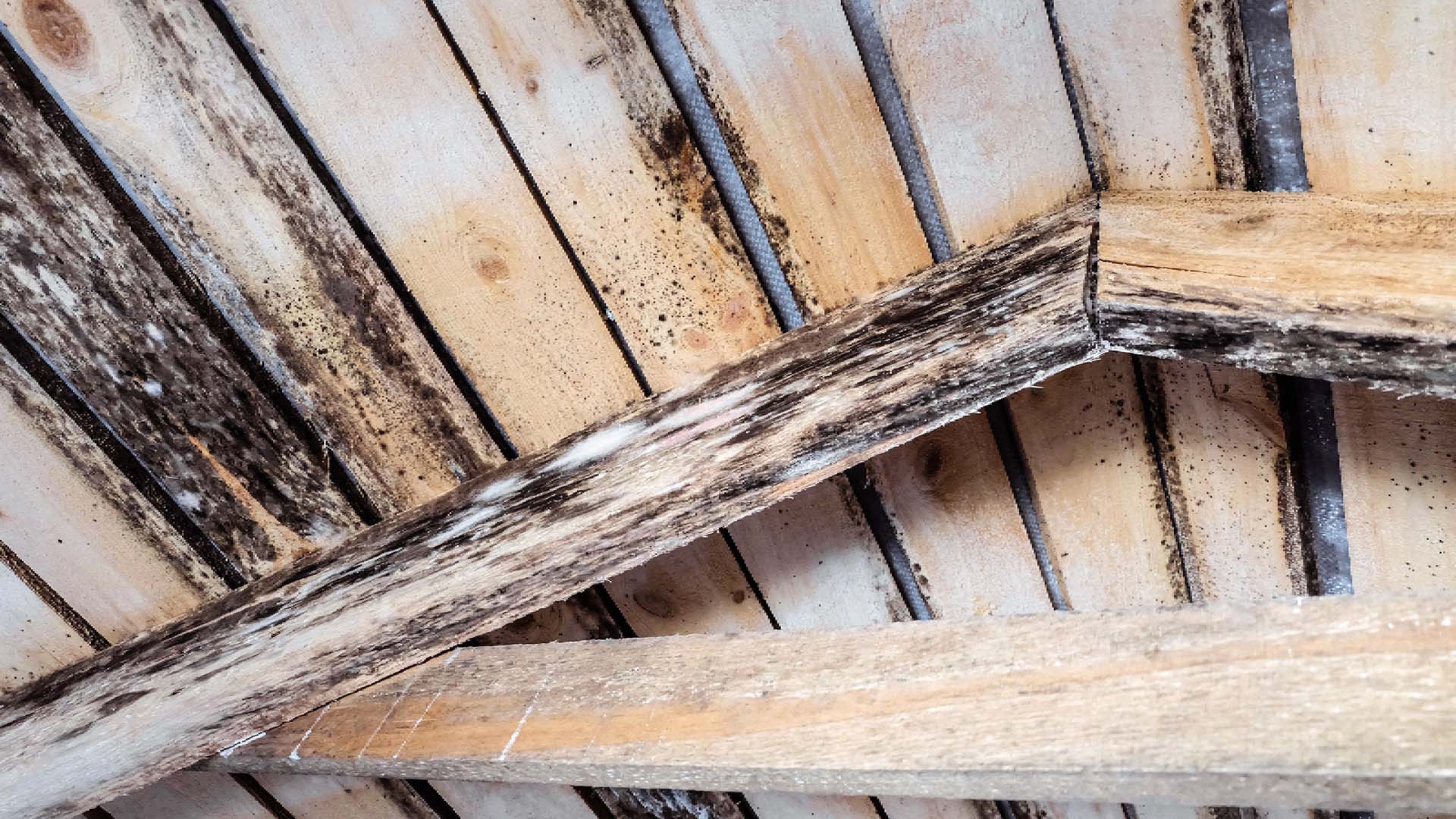Why you need to check your loft for condensation – and how to stop it
Loft condensation left untreated can cause problems, long-term – our expert reveals three tips to stop condensation in its tracks.

Loft condensation left untreated can cause problems, long-term – our expert reveals three tips to stop condensation in its tracks.

“Indoor rain” is the name surveyors give to dampness that’s generated internally in our homes.
In a wet and overcast country like Britain, we focus on keeping rainy weather on the outside, where it belongs. But dampness caused by indoor condensation can be equally damaging to buildings.
And roof spaces are particularly vulnerable to condensation problems, because warm, moisture-laden air naturally rises up to the top of the house.
That’s why it’s important to pop your head through the loft hatch every so often to give the space a health check. Most of us will store belongings, keepsakes and the obligatory Christmas decorations in the loft.
But they can become forgotten spaces, which is when condensation can go unnoticed and take hold.
I’d recommend checking your loft at least twice a year, particularly in the colder months from November through to April, to make sure everything is looking and smelling OK.
If you pop your head through the loft hatch and detect a damp, musty smell, then loft condensation is likely. But don’t worry, there are ways to stop it that won’t dampen your spirits.
After all, you don’t want to find your tinsel and baubles have gone mouldy come December!
After enjoying a nice relaxing bath or a warm shower, the atmosphere in the bathroom can be surprisingly humid and steamy.
When all this airborne water vapour meets a cold surface, it naturally cools, condensing back into water. This is why you often see water globules forming on cold surfaces like toilet cisterns, and sometimes on windows in cold weather.
The same principle is used by advertisers to promote thirst-quenching drinks on hot days with images of ice-cold bottles seductively dripping with droplets of condensed water. But the problem of excessive airborne moisture and humidity in our homes isn’t solely confined to bathrooms.
Activities such as boiling water on the hob and drying clothes indoors can generate huge volumes of water vapour, which can spread throughout the building with the potential to cause damp problems.
Warm air can hold more water vapour than cold air, so when saturated warm air finds its way into a cold loft, it will condense into water because it can no longer accommodate as much moisture.
A certain amount of moisture in the air in our homes is perfectly normal because, as living, breathing beings we naturally emit water vapour. But if this becomes excessive, or the atmosphere is stagnant due to a lack of ventilation, it can result in condensation and dampness.
When checking your loft, the most obvious clue is a dank and festering smell, often accompanied by speckles of black mould staining on roof timbers. Cold surfaces are “damp magnets”, so it’s worth checking things like exposed pipes or water tanks to see if they display sweat-like water beads.

The risk of condensation developing is greater in the winter months because of the difference in temperature with the outdoors. This is when more serious problems can sometimes be detected in lofts, with droplets of water forming on the cold undersides of the roof slates or tiles.
The good news is, if none of these tell-tale signs are evident and your loft is fully insulated and properly ventilated, it should be OK.
There are several potential dangers where lofts are subjected to persistently high moisture levels.
Timbers exposed to damp will sooner or later become vulnerable to rot and wood-boring beetles, ultimately leading to decay, weakening and even structural failure. Where condensation forms on roof slopes, pipes and tanks, it can start to drip like a leaky tap, leading to damp patches on the ceilings of the rooms below.
Another problem is that once loft insulation becomes wet, it loses its effectiveness in retaining heat. And if chipboard decking supporting water tanks is exposed to damp, it can rapidly weaken and disintegrate.
There are three key solutions to prevent loft condensation wreaking havoc:
The first and most obvious course of action is to reduce the amount of water vapour in the indoor atmosphere before it gets anywhere near the loft.
This might simply mean not drying clothes indoors, and ensuring rooms are well ventilated by occasionally opening windows and checking that trickle vents are left open. It also helps to close the door when you have a bath.
But perhaps the most important thing you can do is ensure that extractor fans to kitchens and bathrooms are working effectively, and everyone in the household remembers to keep them switched on.

When it comes to installing or upgrading extractor fans in bathrooms and kitchens, you will need to employ a qualified electrician.
The next step is to identify and seal any pathways where moist, humid air can enter your loft. If the depth of quilt insulation over the ceiling joists is quite sparse and gaps are evident, it will be easier for humid air to find its way through.
So check for any cracks in the plasterwork, particularly where pipes and cables enter the loft and around recessed lighting.
Badly fitting loft hatches are another common cause of air leakage and may need to be sealed around the edges and insulated.
Most older loft hatches open upwards into the loft and can be sealed from below using special ‘P’ shaped rubber strips. These are nailed around the perimeter of the frame under the closed hatch. They have a soft lip that forms a tight seal under pressure when the hatch is in place.
Some installers also fit small hooks to hold the hatch down, but most hatches are heavy enough to stay in place unaided. Alternatively, you could replace your existing loft access with a new ready-made pre-insulated hatch and integral frame.

The third defence is to ensure that if moist air does get into the loft, it can be expelled before it has a chance to condense and cause damp problems. This means ensuring there’s a healthy flow of ventilation in the roof space.
Check that air vents from the eaves or ridge tiles are clear. It’s quite common to find that ventilation paths around the edges of the roof have been blocked by being stuffed with insulation. These must be kept open to ensure a decent through-flow of air to waft away moisture.
Worried about the levels of damp and condensation in your loft? Call in a professional to investigate.
You can get an independent risk assessment from an accredited Energy Performance Certificate (EPC) energy assessor or a chartered surveyor, who can take damp readings in roof timbers with a moisture meter. However, the improvements they will likely recommend will, in most cases, be along the lines of those listed above.
If you’re a competent DIY-er then you should be able to tackle most of these works.
For example, most homes have a number of small cracks in upstairs ceilings. Spending an hour or so applying filler can go a long way in deterring airborne moisture. Similarly, improving loft insulation and ensuring loft hatches fit snugly are relatively cheap and easy fixes.
However, if you’re unsure about what changes to make to fix loft condensation, or you don’t feel comfortable doing it yourself, call in a professional.
As a chartered surveyor, my firm helped one client discover the cause of her water-stained ceiling by going into the loft for her. She was unable to sleep in her bedroom because drops of water were periodically dripping from the ceiling. It transpired that she’d paid out significant sums to have the roof overhauled but this hadn’t solved the problem.
When our surveyors visited the property, they noticed a large brown damp stain on the ceiling, with high moisture readings and loose plasterwork. Access within the loft was restricted by clutter, but there was an unmistakable smell of damp with mould staining on some roof timbers.
After moving some boxes, an innocent-looking length of ducting connected to the bathroom extractor fan was found near the damp patch. This was designed to channel humid air out from the bathroom to a vented tile on a roof slope, but it was clearly ancient, and sagging dramatically.
A closer inspection of the plastic concertina fabric revealed that it had torn at the lowest point. This allowed water vapour to cool, condense and leak over the ceiling, forming a wet patch that was hidden under the insulation.
The problem was solved by fitting a new length of PVC flexible ducting – at the princely sum of £4.39 plus an hour’s labour. We also advised upgrading the loft insulation and ventilation to current standards.
Ian Rock is a Fellow of the Royal Institution of Chartered Surveyors (RICS) and founder of the home survey price comparison website Rightsurvey.
Ian is the author of several best-selling property books, including The Haynes Victorian House Manual, Home Extension Manual and Loft Conversion Manual. He has written for The Observer and is a regular contributor to UK property magazines.










